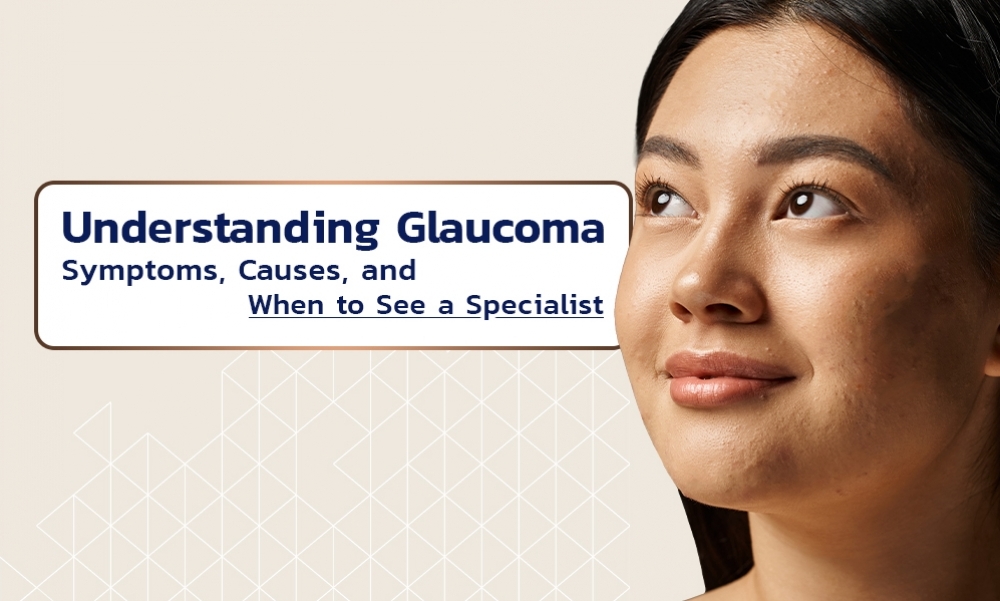What is Glaucoma?
Types of Glaucoma
-
Primary Open-Angle Glaucoma (POAG)
The drainage angle appears open, but fluid drains too slowly. IOP increases gradually and painlessly. Vision loss is typically slow and peripheral, often making it asymptomatic until later stages.
-
Angle-Closure Glaucoma
Occurs when the drainage angle narrows or becomes blocked, preventing fluid outflow. This can cause a sudden, sharp increase in IOP (acute angle-closure), a painful medical emergency, or it can develop gradually.
-
Normal-Tension Glaucoma (NTG)
Optic nerve damage occurs despite IOP remaining within the normal range. While the exact cause isn't fully understood, factors like blood flow to the optic nerve are thought to play a role.
-
Secondary Glaucomas
These develop as a result of other medical conditions, eye injuries, inflammatory diseases, or medications (like steroids).
-
Congenital Glaucoma
A rare form present from birth due to abnormal eye development.
Common Symptoms of Glaucoma
Causes and Risk Factors
-
Age
Risk increases significantly after age 40.
-
Family History
Having a close relative with glaucoma is a strong risk factor.
-
Race/Ethnicity
Higher risk for African descent (POAG) and East Asian descent (angle-closure).
-
Elevated Intraocular Pressure (IOP)
The major modifiable risk factor.
-
Medical Conditions
Diabetes, heart disease, hypertension.
-
Medications
Long-term steroid use, especially eye drops.
-
Eye Trauma or Anatomy
Previous injury or specific eye structures like thin corneas or high refractive errors.
Diagnosing Glaucoma: When to See a Specialist
-
Tonometry
Measures IOP.
-
Ophthalmoscopy
The doctor examines the optic nerve for signs of damage.
-
Visual Field Testing (Perimetry)
Maps peripheral vision to detect blind spots.
-
Optical Coherence Tomography (OCT)
Provides detailed images of the optic nerve and nerve fiber layer to measure thickness and track changes.
-
Gonioscopy
Examines the drainage angle to classify the type of glaucoma.
Glaucoma Treatment Options
-
Medication
Usually prescription eye drops, which reduce fluid production or increase drainage.
-
Laser Therapy
Glaucoma laser surgery is an outpatient option to improve drainage. SLT or ALT can enhance outflow in open-angle glaucoma, while LPI creates an opening in the iris for angle-closure.
-
Surgery
If medication and laser treatments are insufficient, glaucoma surgery may be recommended.
Your glaucoma doctor will discuss the best approach for you, considering disease stage, overall health, and potential risks and benefits. You can find more details on glaucoma here.
Is There a Cure for Glaucoma?
Currently, there is no known cure for glaucoma. Damage already inflicted upon the optic nerve cannot be reversed.
However, this does not mean it cannot be effectively managed. With consistent monitoring and appropriate glaucoma treatment —whether through medication, laser procedures, or glaucoma eye surgery— the progression can often be controlled.
Most patients, when diagnosed early and managed properly by a glaucoma specialist, can prevent severe vision loss and maintain useful sight for life.
Research into nerve repair and new pressure-lowering methods offers future hope, but today's focus remains on detection and control.
Choosing the Right Glaucoma Specialist
Effectively managing a complex condition like glaucoma requires the expertise of a highly skilled and experienced glaucoma ophthalmologist .
At Rutnin Eye Hospital, our dedicated team includes leading glaucoma doctors equipped to provide world-class care. We offer precise diagnosis, personalized management plans, and access to state-of-the-art facilities for all forms of glaucoma operations and laser procedures, with tailored treatments for your specific needs.
Protect Your Vision: Schedule a Glaucoma Evaluation Today
Age, family history, or underlying health conditions increase your vulnerability to this silent disease. Rutnin Eye Hospital offers comprehensive glaucoma evaluations led by experienced glaucoma ophthalmologists. We provide the advanced diagnostics and tailored care necessary to detect and manage this condition effectively.
Make an appointment today. Protect your future vision with Bangkok's leading eye hospital.
 02-056-3333
02-056-3333





